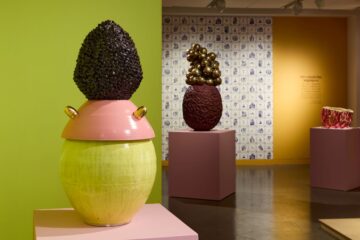
Originally published in The Voice of San Francisco in December 2025
The Museum of African Diaspora (MOAD) presents a group exhibition of innovative furnishings, wall treatments, lighting, and more by contemporary African diasporic designers. Liberatory Living: Protective Interiors & Radical Black Joy features international artists, ceramicists, and furniture makers across all three floors of the museum.
Diaspora and the Idea of Home
The word diaspora means the dispersion or spread of people from their original homeland, a group of people scattered across the world but identified with a specific geographic location. Liberatory Living crafts domestic technologies, products and environments that center belonging and the preservation of the Black radical tradition. Home in this sense has a broader definition beyond the place we go at the end of the day, the place where our objects are located, and the place where we eat and sleep. Home is a reflection of culture, home is where the décor and ornamentation reflects personal histories and the place where we revitalize joy.
“Working across disparate mediums, geographies, and philosophies, the designers and artists in Liberatory Living respond to the enduring need to construct a space of one’s own,” said Key Jo lee, Chief of Curatorial Affairs and Public Programs. “Their practices insist upon safe-keeping and harnessing joy against diasporic histories of uprootedness, dwelling within the restorative power of inhabiting beauty.”
Homeplace and the Black Interior
Liberatory Living will unite the late feminist theorist bell hooks’ concept of “homeplace” with scholar Elizabeth Alexander’s notion of the “Black Interior.” The first floor includes Love Quest by multidisciplinary artist Nandipha Mntambo, a concave, basin-like chair that hugs and embraces the sitter, made from leather and timber. Sandra Githinji Studio’s nearby sculptural floor lamp references African hair styles, with a light source symbolizing communication with the divine. Along the corridor, framed archival pigment prints from Kapwani Kiwanga’s Greenbook series documents safe places to lodge and dine for African-American motorists traveling through the country. These works are reproductions of annual state by state listings published in a guidebook from 1936 to 1966.
The Dignity Gallery on the second floor features the designer and social practice artist Norman Teague and his large-scale “cabinet of curiosities,” and behind this will be a special wallpaper – black and white self-portraiture radically depicting black existence- by Zanele Muholi. Designer Sheila Bridges makes her own statement in her wallpaper using her renowned “Harlem Toile du Jouy” and “Zwarte Piet” patterns, which reexamine and sharply recast the Toile du Jouy pattern from 18th century France and the folkloric Dutch holiday imagery of Sinterklass and his servant, respectively. From a distance it appears to be a whimsical antique wallpaper but the story is told up close, with figures and events taking on a new, updated meaning upon closer examination. Traditional forms are echoed again in the work of furniture designer Michael Bennett’s Pews (2023). The seats bring together five irregularly rounded, abstract shapes that look organic, as though they grew up from the ground like mushrooms, inspired by African diasporic gatherings. Franco-Beninese artist King Houndekpinkou’s glazed stoneware vessels reference altars of the Voodoo tradition in Benin.
The third floor features ceramic furniture by Chuma Maweni from his Imbizo Ibanjiwe series. Maweni exhibits a hand-crafted dining table and chairs –reminiscent of chess pieces– symbolizing a modern-day “imbizo”, a forum or meeting called by a traditional Xhosa or Zulu leader. Another interplay between the natural world and the indoors is present in the French design duo dach&zephir’s brass lighting sources inspired by tropical plant leaves found along the rivers in the Guadeloupe islands in the Caribbean. Organic forms in wood, mixed media, silk, wire and fabric create the stuff of home. In Liberatory Living, objects reflect a sense of place and everyday function. The deeper meanings reside behind the objects, their stories echoing with tales from history, touching on the idea of safety and belonging – the very definition of home.